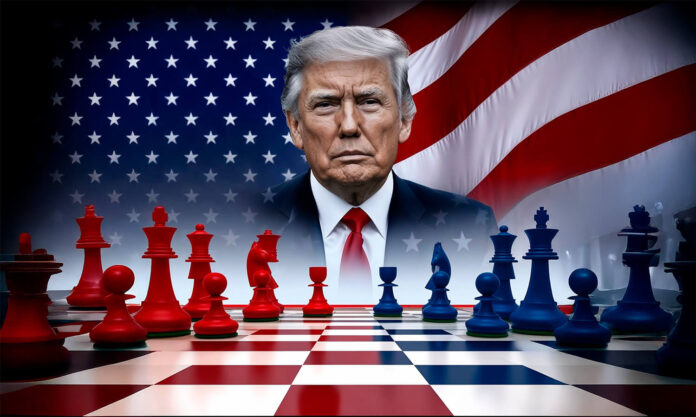The 2024 U.S. presidential election was a political earthquake that left pundits and analysts scrambling to understand how they got it so wrong—again. At the center of this surprise victory was the silent majority, a diverse coalition of voters who had grown tired of being overlooked. In my How Trump Played the Media…Again, the Trump election is meticulously analyzed, revealing how the campaign strategically tapped into cultural shifts, economic anxieties, and social media to rewrite the political playbook.
Discover more about my book here.
In this article, we’ll explore the return of the silent majority, how it shaped the 2024 Trump election, and what future campaigns can learn from this powerful movement. Let’s break down the cultural, economic, and digital forces that drove this voter base and changed the trajectory of American politics.
Who Is the Silent Majority Today?
The term silent majority originated in a 1969 speech by President Richard Nixon, referring to the Americans who weren’t protesting in the streets but still had strong opinions about the country’s direction. Fast forward to 2024, and the silent majority returned with new faces and new grievances. In How Trump Played the Media…Again, I again described this coalition:
“The 2024 silent majority wasn’t confined to the rural Midwest or older generations. It was a far more diverse and dynamic group: suburban parents, economically displaced workers, disillusioned minorities, and young professionals—united not by ideology, but by a shared feeling of alienation.”
This coalition, largely ignored by mainstream media, quietly organized and mobilized in key battleground states. They didn’t dominate cable news, but they made their voices heard where it mattered most—at the ballot box.
Cultural and Economic Catalysts
1. Parental Rights and Cultural Shifts
Parental rights in education became a central issue in 2024. Across the country, debates over school curricula, gender identity policies, and parental involvement fueled voter mobilization. Suburban parents who felt excluded from these conversations found a champion in Donald Trump. His campaign capitalized on this cultural anxiety by promoting parental rights and pushing back against what it framed as government overreach.
As I noted in How Trump Played the Media…Again:
“Parental rights became a defining issue in suburban America in 2024. It wasn’t just about school boards; it was about control—control over their children’s education, values, and future.”
For more on how education became a critical political battleground, read How Parental Rights Shaped U.S. Elections on Gossip Stone.
2. Economic Uncertainty and Working-Class Disillusionment
While cultural issues were a rallying cry, economic anxiety remained a key driver. In Rust Belt states like Michigan and Ohio, many voters felt abandoned by globalization and automation. Factories that once provided stable jobs had long since closed, leaving communities struggling to rebuild. Trump’s promise to restore American manufacturing and prioritize domestic jobs struck a deep chord.
In How Trump Played the Media…Again, I highlighted how this economic message resonated:
- Protectionism over free trade: Trump emphasized protecting American jobs from overseas competition.
- Appeals to nostalgia: Economic messaging tapped into memories of better times and the hope of their return.
- Localized messaging: Voters in manufacturing towns received targeted ads promising specific solutions to their economic woes.
For more on how the economy shaped the Trump election, visit Economic Trends and Voter Behavior in 2024.
The Silent Majority Goes Digital
The 2024 Trump election wasn’t just a political battle—it was a digital war. As Avakyan notes, social media played a pivotal role in giving the silent majority a voice that traditional media had ignored.
Hashtags and Memes: The New Political Currency
The hashtag #MAGA2024 became a viral phenomenon. Unlike TV ads or long-form debates, memes and short viral videos allowed the campaign to reach millions in seconds. Supporters shared relatable, humorous, and emotionally charged content that reinforced the campaign’s message.
Did you know? Memes about key economic promises and parental rights policies garnered millions of views, helping solidify the campaign’s online presence. For more on this phenomenon, read The Rise of Memes in Political Campaigns.
Micro-Targeting: Reaching Voters Where It Counts
Trump’s campaign also mastered micro-targeting, delivering highly personalized ads based on voter data. This strategy ensured that every voter received a message that spoke to their specific concerns:
- Rural communities received content about agricultural subsidies and trade protections.
- Urban professionals saw ads about tax cuts and job growth in tech sectors.
- Suburban mothers were targeted with messaging about school choice and parental rights.
This precision gave the campaign a significant edge over more generalized media strategies.
Mainstream Media’s Misstep
One of the most surprising aspects of the 2024 Trump election was how mainstream media failed to see the silent majority coming. In How Trump Played the Media…Again, I explained how media outlets focused heavily on progressive narratives while ignoring the growing frustration in rural and suburban areas.
Flawed Polling Models
Pollsters once again underestimated Trump’s support, particularly in swing states. This wasn’t just a failure of methodology—it was a failure to understand the motivations of key voter groups. For a deeper dive into polling mistakes, check out Why Polls Keep Getting It Wrong.
Media Bias and the Echo Chamber Effect
By focusing on urban-centric issues and dismissing opposing perspectives, many media outlets created an echo chamber that excluded large swaths of the population. The silent majority’s ability to bypass traditional media and create its own narratives on social media was key to its success.
Lessons for Future Campaigns
The 2024 Trump election offers critical lessons for candidates, media professionals, and voters alike:
1. Hyper-Localization Matters
Campaigns that speak directly to voters’ regional concerns will always have an advantage. Localized messaging makes voters feel seen and heard.
2. Listen to Diverse Voices
The silent majority is far from monolithic. Successful campaigns must engage with a broad range of perspectives to build genuine connections.
3. Leverage Digital Tools
Social media is here to stay, and campaigns must continue to innovate. However, using these tools responsibly—without spreading misinformation—is crucial for maintaining voter trust.
For more on responsible digital strategy, read How Digital Campaigns Shape Modern Politics.
The Silent Majority and the Future of American Democracy
The 2024 election proved that the silent majority is a force that can no longer be ignored. As I wrote in How Trump Played the Media…Again, understanding this coalition is essential for anyone hoping to navigate the complex future of American politics.
By adapting to the digital age and finding new ways to amplify their voice, the silent majority has shown it’s here to stay. Whether future candidates can learn from their success—or repeat the mistakes of the past—will determine the course of the next election.
For a detailed breakdown of the 2024 election and lessons for future campaigns, check out my new book How Trump Played the Media…Again, coming soon to all major online book distributors.




